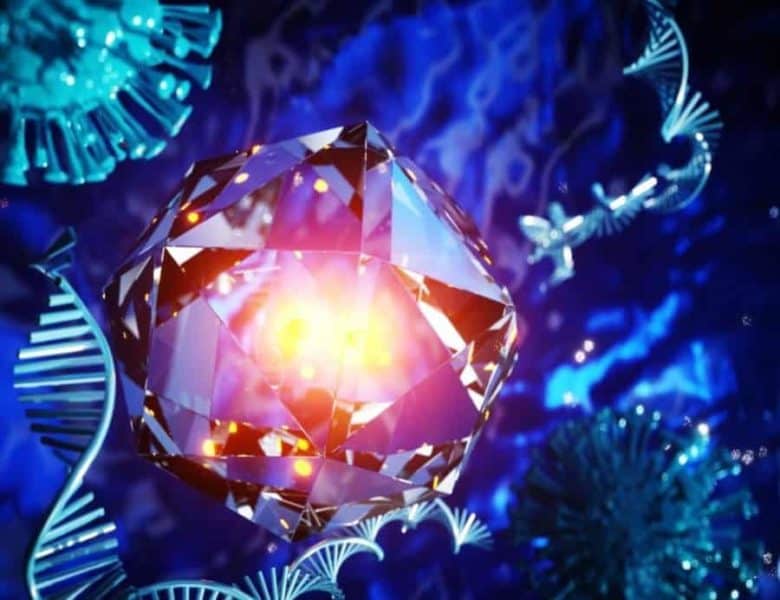Paper-based lateral flow tests work the same way as a pregnancy test in that a strip of paper is soaked in a fluid sample and a change in colour – or fluorescent signal – indicates a positive result and the detection of virus proteins or DNA. They are widely used to detect viruses ranging from HIV to SARS-CoV-2 (lateral flow tests for Covid-19 are currently being piloted across England) and can provide a rapid diagnosis, as the results do not have to be processed in a lab.
The new research, published in Nature, found that low-cost nanodiamonds could be used to signal the presence of an HIV disease marker with a sensitivity many thousands of times greater than the gold nanoparticles widely used in these tests.
This greater sensitivity allows lower viral loads to be detected, meaning the test could pick up lower levels of disease or detect the disease at an earlier stage, which is crucial for reducing transmission risk of infected individuals and for effective treatment of diseases such as HIV.
The research team are working on adapting the new technology to test for COVID-19 and other diseases over the coming months. A key next step is to develop a hand-held device that can “read” the results, as the technique was demonstrated using a microscope in a laboratory. Further clinical evaluation studies are also planned.
Lead author Professor Rachel McKendry, Professor of Biomedical Nanotechnology at UCL and Director of i-sense EPSRC IRC, said: “Our proof-of-concept study shows how quantum technologies can be used to detect ultralow levels of virus in a patient sample, enabling much earlier diagnosis.
“We have focused on the detection of HIV, but our approach is very flexible and can be easily adapted to other diseases and biomarker types. We are working on adapting our approach to COVID-19. We believe that this transformative new technology will benefit patients and protect populations from infectious diseases.”
The researchers made use of the quantum properties of nanodiamonds manufactured with a precise imperfection. This defect in the highly regular structure of a diamond creates what is called a nitrogen-vacancy (NV) centre. NV centres have many potential applications, from fluorescent biomarking for use in ultra-sensitive imaging to information processing qubits in quantum computing.
The NV centres can signal the presence of an antigen or other target molecule by emitting a bright fluorescent light. In the past, fluorescent markers have been limited by background fluorescence, either from the sample or the test strip, making it harder to detect low concentrations of virus proteins or DNA that would indicate a positive test. However, the quantum properties of fluorescent nanodiamonds allow their emission to be selectively modulated, meaning the signal can be fixed at a set frequency using a microwave field and can be efficiently separated from the background fluorescence, addressing this limitation.
The optical results showed up to a five orders of magnitude (100,000 times) improvement in sensitivity compared to gold nanoparticles (that is, a much lower number of nanoparticles were required to generate a detectable signal). With the inclusion of a short 10-minute constant-temperature amplification step, in which copies of the RNA were multiplied, the researchers were able to detect HIV RNA at the level of a single molecule in a model sample.
The work was demonstrated in a laboratory setting but the team hopes to develop the tests so that the results could be read with a smartphone or portable fluorescence reader. This means that the test could, in future, be performed in low-resource settings, making it more accessible to users.
First author Dr Ben Miller (i-sense Postdoctoral Research Associate at the London Centre for Nanotechnology at UCL) said: “Paper-based lateral flow tests with gold nanoparticles do not require laboratory analysis, making them particularly useful in low resource settings and where access to healthcare is limited. They are low cost, portable, and user friendly.
“However, these tests currently lack the sensitivity to detect very low levels of biomarkers. By replacing commonly used gold nanoparticles with fluorescent nanodiamonds in this new design, and selectively modulating their (already bright) emission of light, we have been able to separate their signal from the unwanted background fluorescence of the test strip, dramatically improving sensitivity.”
Professor John Morton, Director of UCL’s Quantum Science and Technology Institute (UCLQ) and a co-author of the paper, said: “This interdisciplinary collaboration between UCLQ and the i-sense team in the LCN is a fantastic illustration of how foundational work on quantum systems, such as NV centre in diamond, can evolve from the lab and play a crucial role in real-world applications in sensing and diagnostics. Researchers at UCLQ are exploring and enabling the impact of these and other quantum technologies by working with industry and other academic research groups.”
The study was carried out by an interdisciplinary team of i-sense researchers from UCL, UCLH, and University of Oxford, led by the London Centre for Nanotechnology at UCL. i-sense is an Interdisciplinary Research Collaboration (IRC) funded by the UK Engineering and Physical Sciences Research Council (EPSRC).
This work was funded by the UK EPSRC, Royal Society, London Centre for Nanotechnology, H2020 European Research Council, the UCLH NHS Foundation Trust and supported by the National Institute for Health Research University College London Hospitals Biomedical Research Centre.


